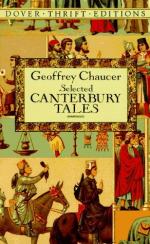|
This section contains 606 words (approx. 2 pages at 400 words per page) |

|
In the following essay, Hanning compares "The Knight's Tale" with epics by Boccaccio and Statius to gain a greater understanding of the themes of nobility and order in the poem.
There is perhaps no better illustration of the processes of continuity and change in medieval literature than the relationship between Geoffrey Chaucer's "Knight's Tale" (1386?), first of the Canterbury Tales, and its literary antecedents, both proximateGiovanni Boccaccio's Teseida delle nozze d'Emilia (ca. 1340)and remotethe Thebaid of Statius (ca. 92 AD). Moreover, a comparison of Chaucer's poem with Statius's epic and Boccaccio's epic romance offers important clues to the meaning of one of the most problematic tales in the Canterbury collection.
To Boccaccio and Chaucer, and to medieval authors generally, Statius was the authority on the fall of Thebes, one of the most traumatic events of classical legend. Charles Muscatine, in the most influential, and perhaps the finest...
|
This section contains 606 words (approx. 2 pages at 400 words per page) |

|




